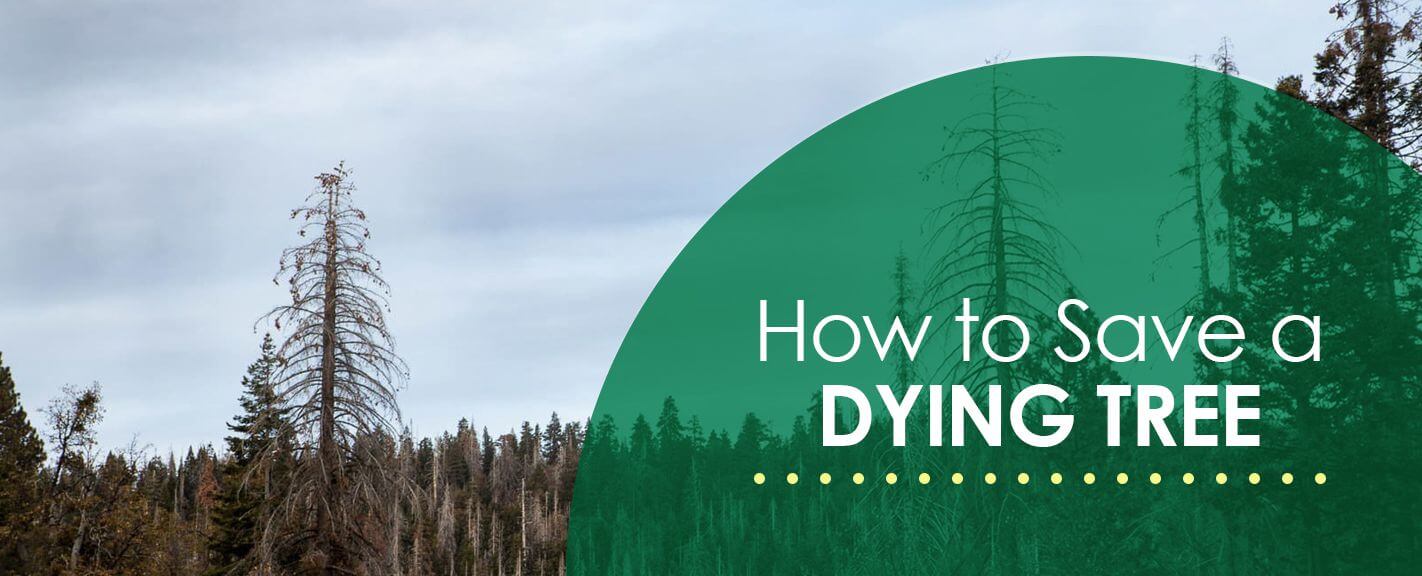
New York City is best known for its bright lights, tall buildings and concrete masses interconnecting this bustling place. “Cementland,” as some call the Big Apple, isn’t well associated with green spaces, especially the wide variety of trees found in the urban forest. Many of New York’s trees, however, are native species that were thoughtfully preserved by previous generations as the city expanded. But today, many local homeowners and property managers need help knowing how to save a dying tree.
Trees are living creatures. They require water, food, light and other life necessities just like humans. As with people, trees get old, diseased and injured. Eventually, trees die, which is part of nature’s lifecycle. But trees don’t have to perish prematurely as long as you know how to save them.
According to an in-depth study by the US Department of Agriculture (USDA) forest service, there are nearly seven million mature evergreen and deciduous trees and 138 different species within New York City Limits. That’s nearly a tree per person.
Tree canopies cover 21 percent of the city and have an estimated compensatory value of $5.7 billion. New York trees also store 1.2 million tons of carbon, remove 1,100 tons of air pollutants and reduce residential energy costs by $17.1 million each year.
IMPORTANCE OF TREES
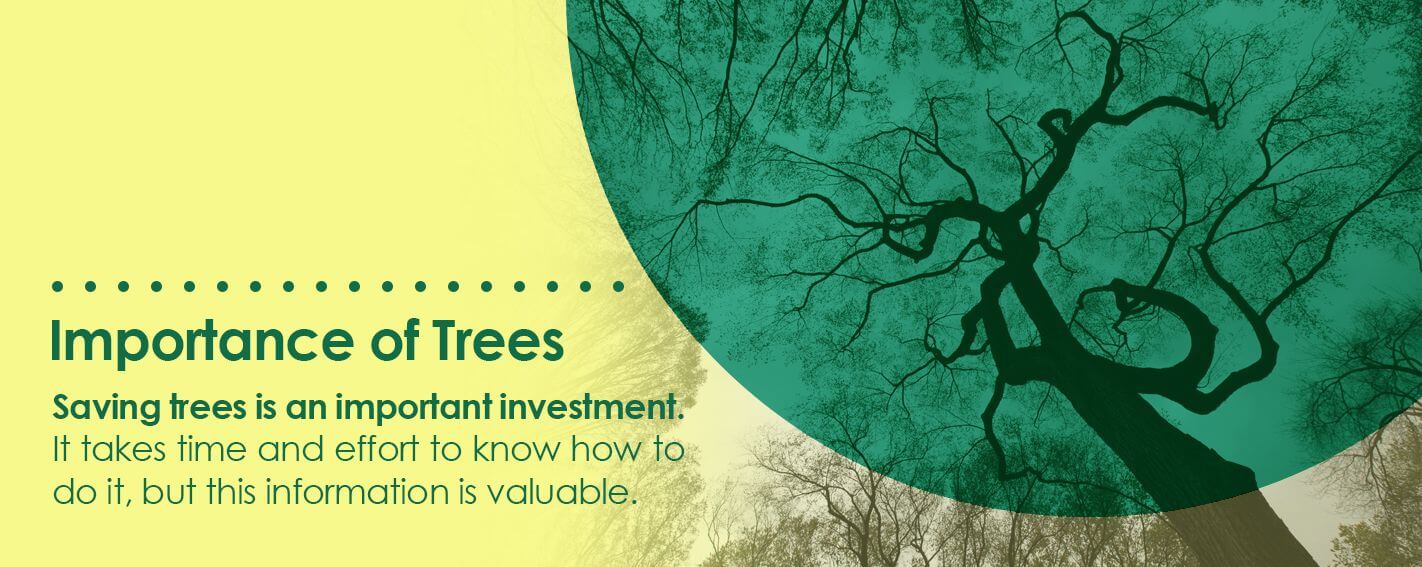
New York’s trees are highly important to locals’ health, comfort and enjoyment of life. Trees provide significant benefits socially, communally, environmentally and economically. Few may consider it, but New Yorkers would be devastated if their trees died off. That’s why it’s imperative we know how to save a tree from sickness and death.
Saving dying trees is an important investment. It takes time and effort to know how to do it, but this information is valuable. Here are some of the critical reasons why we should save a dying tree:
- Reduce Air Pollution: Trees scrub pollutants from the air by taking in carbon dioxide and releasing oxygen.
- Provide Groundwater Control: Tree root systems help retain groundwater and preserve aquifers.
- Slow Surface Water Runoff: Trees help retain stormwater and slow surface runoff into sewer systems, streams and rivers.
- Provide Ultraviolet Light Protection: Leaf and needle canopies filter UV rays that can harm human health.
- Help Control Temperatures: Trees provide shade to cool buildings in the summer and protect heat loss in winter:
- Protect From the Wind: Healthy evergreens and deciduous trees provide effective windbreaks to protect people and structures.
- Create Wildlife Habitat: Urban trees are critical to support mammals, birds, reptiles, amphibians and insects.
- Generate Employment: Many people such as arborists, pruners and tree removal experts depend on trees for their livelihood.
- Provide Enjoyment: Healthy and abundant trees are essential for human enjoyment, recreation and relaxation.
- Have an Economic Benefit: The tree industry generates money for the economy while saving money through energy conservation.
SIGNS THAT YOUR TREE IS DYING
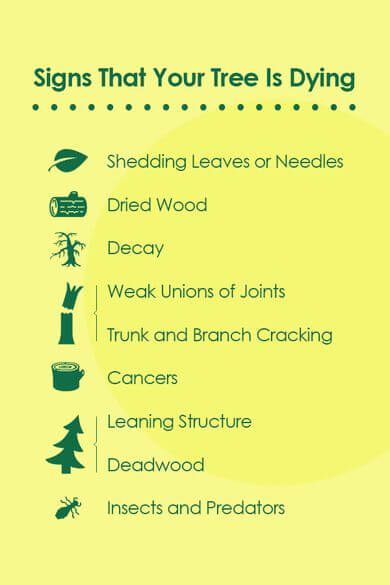
The first step in saving a sick or dying tree is to recognize the symptoms it’s presenting with a tree inspection. For instance, when you see a pine tree turning brown and losing needles, you’ll immediately suspect something wrong.
As its name suggests, it’s not normal for an evergreen to turn brown.
Knowing how to save a dying pine tree is not much different than knowing how to save any other species of tree, including evergreen and deciduous varieties.
All trees have similar life support systems, and all will show certain signs if the tree is dying. The trick is being able to spot those signs.
It’s important to know that a tree that appears dead may still be very much alive. Sick trees often go into dormancy and appear to play dead. Fortunately, most trees give you plenty of warning and cry out for help by showing symptoms.
Here are the most common signs that your tree is dying:
- Shedding Leaves or Needles: This is the most common symptom that your tree is in distress, so be sure to watch for it. Evergreens, by nature, don’t shed needles unless they have a problem. By recognizing the issue and diagnosing it, you can then take appropriate action or intervention with evergreen softwood trees. Deciduous trees are seasonal. Nature designed these hardwood trees to cycle throughout the year. While it’s natural for leafy trees to shed in the fall, it’s not natural for them to prematurely drop leaves in the spring or mid-summer.
- Dried Wood: Healthy trees retain water in their bark and pulp. If you note extreme dryness appearing on your tree’s trunk or branches, this should be a red flag. Healthy trees will have elasticity in their limbs. If you notice cracked bark or limbs that won’t flex, this is a symptom of sickness. Dried trunks and branches won’t bend as they normally should. If you put pressure on an ill tree’s branch with dried wood, it’ll probably crack and break away.
- Decay: Seeing rot or decay on any part of your tree is a serious trouble sign. Although decay is part of nature’s after-death recycling process, it certainly isn’t healthy for a living tree. Decay happens when the cellulose fibre in a tree breaks down. An obvious decay symptom is seeing an external mushroom or fungi growth on any part of your tree. Tree decay can be hard to spot until it’s well advanced. Trees normally rot from the inside out, and by the time you’re seeing decay evidence, there’s significant damage.
- Weak Unions of Joints: Trees often show signs of illness at the unions where limbs and trunks join. If you see any sign of cracking or abnormal sagging at the union points, this is another clear signal that your tree may be dying. Unions are critical junctions for a tree’s health and survival. Weak trees can fail at their unions and cause branches to droop or snap off. Healthy unions are sturdy and resilient, whereas weak trees will fail at their union points.
- Trunk and Dead Branch Cracking: Cracks in your tree’s trunk or branches can be tough to diagnose as illness evidence. You can expect a certain amount of cracks to appear in any tree structure, especially as they age. The ones to watch for are vertical cracks that have continuous runs between limb joints as well as cracks that connect around the limb or trunk circumference. Cracks appearing in only your tree’s bark might not be worrisome. However, if you can see raw wood through the cracks, there is likely an issue with your tree’s health.
- Cancers: These are disease spots that you might see on your tree bark. They’re similar to tumours people get, and they can result from stress. Your tree might experience stress from drought, overwatering, excessive heat, harsh cold or even high wind. Stresses cause your tree to break out in cancers. This might be an early warning sign that your tree needs attention before the stress becomes severe enough to kill it.
- Leaning Structure: If your tree develops an unnatural lean to one side, this is a sign of root failure. Unstable or unhealthy root systems can’t support your tree’s weight, so gravity forces exceed the root strength. Leaning trees are a serious sign of problems hidden below ground. Weak or dying roots quickly affect the remainder of your tree. By the time you notice an abnormal posture, it might be too late to save your tree. To prevent damage to adjacent property, it’s wise to have a dying tree professionally removed and disposed of.
- Deadwood: This is a sure sign of a dying tree. Trees normally decline and pass away gradually rather than suddenly. It’s common for parts of a tree to die and remain on the branches or attached to the trunk while the remainder of the tree appears perfectly healthy. Expired parts of a tree are called deadwood. They should be removed before the problem harming the isolated location spreads to the rest of the tree. Deadwood normally snaps off from minimal pressure, but it may require a professional tree service to intervene.
- Insects and Predators: While your trees may be necessary hosts to wildlife like insects, birds and rodents, that hospitality can go too far. Insect infestations are a leading cause of premature tree death. If you see insect colonies and your tree seems stressed, you need to control this problem as soon as possible. Watch for signs of destructive bird evidence around your trees, too. Woodpeckers and sapsuckers know when your tree is vulnerable. Freshly poked holes and woodchips on the ground are positive signs that your tree has problems and may well be about to die.
If you have evergreen trees, pay particular attention to needle cast or dropping needles, browning or discoloration, and rust spots, which are orange-colored bark blisters. These are the three leading symptoms of an evergreen tree ready to check out. Pine trees are particularly popular in New York. So are northern white cedar trees. Both species are susceptible to drought conditions. Drought commonly causes needle cast and browning, while fungal infections show dangerous rust spots that indicate tree death is on its way.
WHAT TO DO IF YOU TREE IS DYING
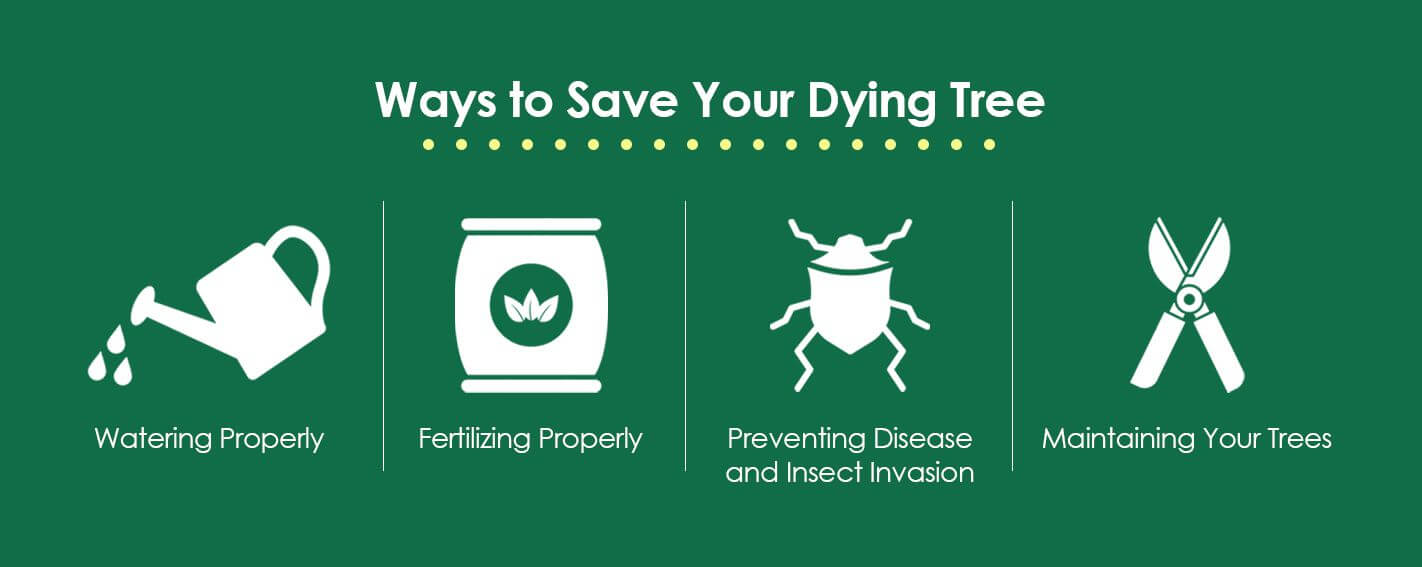
The best defence in saving your dying tree is developing a good offence. That means being on guard for your trees and keeping a vigilant watch for any evident signs that your tree is sick. Proactive intervention is critical to saving a once-healthy tree before it crosses a point of no return.
When it comes to saving your trees, prevention is the best intervention. Here are the top ways you can save your tree from dying:
- Watering the Tree Properly: Drought conditions, or lack of proper watering, are the leading cause of tree stress and early death. As soon as you see a troubling sign in your tree’s appearance, check the soil conditions for moisture. Make sure water is getting to your tree roots, and you might have to do some deep root watering. Conversely, overwatering can also stress your tree with root flooding, which makes it unable to absorb oxygen.
- Fertilizing Properly: Lack of food can also threaten your tree’s life. Trees function by taking water and nutrients from the soil and converting light to energy through photosynthesis. If your tree doesn’t absorb the right nutrients, it won’t survive, regardless if it gets the right amount of water and sunlight. Over-fertilizing can also harm your tree. It’s wise to have the soil around your tree tested before attempting any fertilizer adjustment. This is inexpensive insurance to protect an expensive tree.
- Preventing Disease and Insect Invasion: Disease is a common reason why seemingly healthy trees suddenly become sick and die. Disease types vary between species and are easily spread by way of airborne spores or transfer through insect travel. Common tree diseases and invasive insects in New York include American chestnut blight, Dutch elm disease, Armillaria root rot, Southern pine beetles, Asian longhorned beetles and emerald ash borers. Oak wilt is another common and deadly tree disease found in the area. These diseases and insects are serious tree threats that are best dealt with by certified arborists employed by a professional tree service.
- Maintaining Your Trees: Maintaining your trees throughout the year is paramount if you truly want to save them from dying. Well-maintained trees are less likely to suffer disease and insect invasion. Properly watered and fertilized trees also stand a better chance of trouble-free lives compared to neglected specimens. Proper pruning and mulching of your trees are also mandatory tasks for preserving them. However, there are tricks to tree maintenance. Some things are best left to the experts, particularly if you have to remove a tree when it dies.
WHAT TO DO IF YOUR TREE DIES
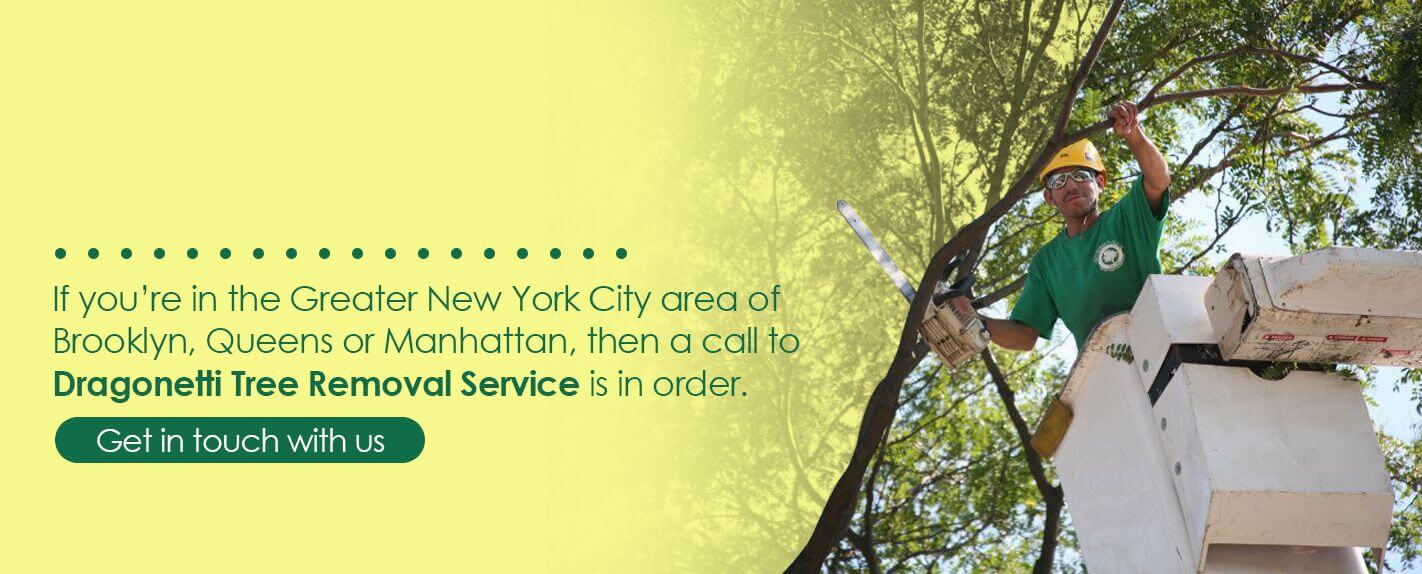
Sadly, there are times when all the care in the world isn’t enough to save a dying tree. You might have to make the difficult choice to end its suffering and have your tree removed. After all, its quality of life is gone, and the best thing you can do is return your tree to nature.
If your tree is dying or dead, you might not have the skill or equipment to remove it by yourself. If you’re in the Greater New York City area of Brooklyn, Queens or Manhattan, then contacting an arborist like Dragonetti Tree Removal Service is in order.
We have the professional ability to safely remove and dispose of large trees for homeowners, property managers, landlords and building contractors in the NYC area. We are highly experienced with both evergreen and deciduous trees that have reached their end or pose a threat to others. In addition, we have tree trimming, pruning and stump grinding capabilities as well as ISA Certified Arborists and TCIA Certified Tree Care professionals on staff.
For the best tree removal and maintenance service available in New York City, contact Dragonetti Tree Removal today. We’ll develop a free quote and safely look after your needs. Call us at 718-288-8733 or get in touch with us through our online contact form today.
